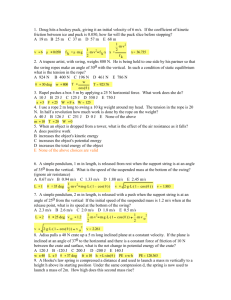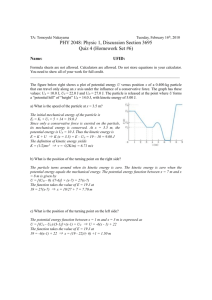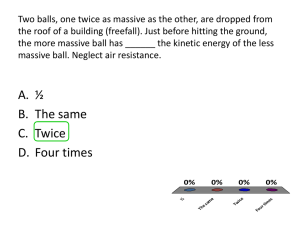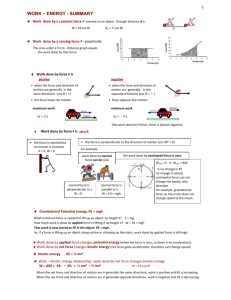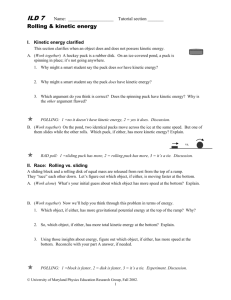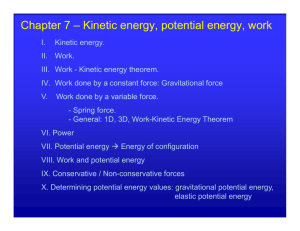Physics 140 HOMEWORK Chapter 7A Q1. Rank the following
advertisement
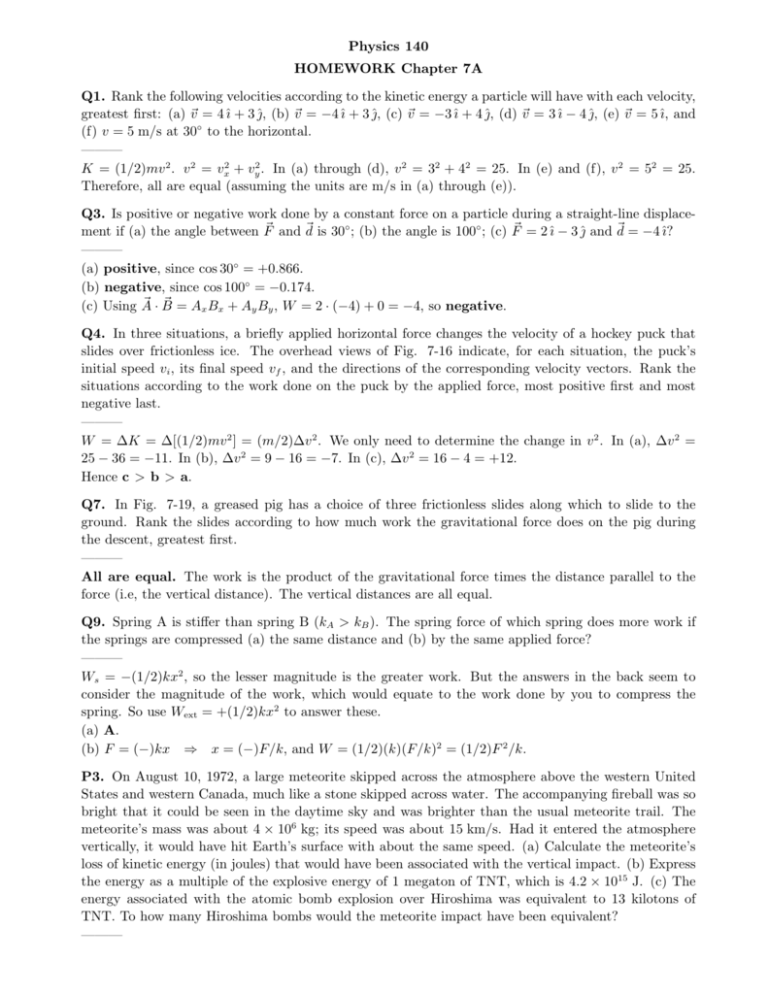
Physics 140 HOMEWORK Chapter 7A Q1. Rank the following velocities according to the kinetic energy a particle will have with each velocity, greatest first: (a) ~v = 4ı̂ + 3 ̂, (b) ~v = −4ı̂ + 3 ̂, (c) ~v = −3ı̂ + 4 ̂, (d) ~v = 3ı̂ − 4 ̂, (e) ~v = 5ı̂, and (f) v = 5 m/s at 30◦ to the horizontal. ——— K = (1/2)mv 2 . v 2 = vx2 + vy2 . In (a) through (d), v 2 = 32 + 42 = 25. In (e) and (f), v 2 = 52 = 25. Therefore, all are equal (assuming the units are m/s in (a) through (e)). Q3. Is positive or negative work done by a constant force on a particle during a straight-line displace~ and ~d is 30◦ ; (b) the angle is 100◦ ; (c) F ~ = 2ı̂ − 3 ̂ and ~d = −4ı̂? ment if (a) the angle between F ——— (a) positive, since cos 30◦ = +0.866. (b) negative, since cos 100◦ = −0.174. ~ ·B ~ = Ax Bx + Ay By , W = 2 · (−4) + 0 = −4, so negative. (c) Using A Q4. In three situations, a briefly applied horizontal force changes the velocity of a hockey puck that slides over frictionless ice. The overhead views of Fig. 7-16 indicate, for each situation, the puck’s initial speed vi , its final speed vf , and the directions of the corresponding velocity vectors. Rank the situations according to the work done on the puck by the applied force, most positive first and most negative last. ——— W = ∆K = ∆[(1/2)mv 2 ] = (m/2)∆v 2 . We only need to determine the change in v 2 . In (a), ∆v 2 = 25 − 36 = −11. In (b), ∆v 2 = 9 − 16 = −7. In (c), ∆v 2 = 16 − 4 = +12. Hence c > b > a. Q7. In Fig. 7-19, a greased pig has a choice of three frictionless slides along which to slide to the ground. Rank the slides according to how much work the gravitational force does on the pig during the descent, greatest first. ——— All are equal. The work is the product of the gravitational force times the distance parallel to the force (i.e, the vertical distance). The vertical distances are all equal. Q9. Spring A is stiffer than spring B (kA > kB ). The spring force of which spring does more work if the springs are compressed (a) the same distance and (b) by the same applied force? ——— Ws = −(1/2)kx2 , so the lesser magnitude is the greater work. But the answers in the back seem to consider the magnitude of the work, which would equate to the work done by you to compress the spring. So use Wext = +(1/2)kx2 to answer these. (a) A. (b) F = (−)kx ⇒ x = (−)F/k, and W = (1/2)(k)(F/k)2 = (1/2)F 2 /k. P3. On August 10, 1972, a large meteorite skipped across the atmosphere above the western United States and western Canada, much like a stone skipped across water. The accompanying fireball was so bright that it could be seen in the daytime sky and was brighter than the usual meteorite trail. The meteorite’s mass was about 4 × 106 kg; its speed was about 15 km/s. Had it entered the atmosphere vertically, it would have hit Earth’s surface with about the same speed. (a) Calculate the meteorite’s loss of kinetic energy (in joules) that would have been associated with the vertical impact. (b) Express the energy as a multiple of the explosive energy of 1 megaton of TNT, which is 4.2 × 1015 J. (c) The energy associated with the atomic bomb explosion over Hiroshima was equivalent to 13 kilotons of TNT. To how many Hiroshima bombs would the meteorite impact have been equivalent? ——— (a) K = (1/2)mv 2 = (1/2)(4 × 106 kg)(1.5 × 104 m/s)2 = 4.5 × 1014 J. Be alert to convert km to m; astronomers like to state speeds in km/s. (b) (4.5 × 1014 J)/[(4.2 × 1015 J)/ MT] = 0.11 MT. (c) (0.11 MT)/(0.013 MT) = 8.5. P5. A father racing his son has half the kinetic energy of the son, who has half the mass of the father. The father speeds up by 1.0 m/s and then has the same kinetic energy as the son. What are the original speeds of (a) the father and (b) the son? ——— Let mf be the mass of the father, in which case the mass of the son is mf /2. We have the equations: (1/2)mf vf2 = (1/2) × (1/2)(mf /2)vs2 ; and (1/2)mf (vf + 1)2 = (1/2)(mf /2)vs2 . The first equation yields that vs = 2vf . Substitute into the second equation and solve the quadratic to get (a) vf = 2.414 m/s. (b) vs = 4.818 m/s. P11. A 12.0 N force with a fixed orientation does work on a particle as the particle moves through the three-dimensional displacement ~d = (2.00ı̂ − 4.00 ̂ + 3.00 k̂) m. What is the angle between the force and the displacement if the change in the particle’s kinetic energy is (a) +30.0 J and (b) −30.0 J? ——— ~ · ~d = |F ~ | |~d| cos θ. Hence Recall that W = F ~ ~ cos θ = √ W/(|F | |d|). |~d| = 22 + 42 + 32 = 5.39 m. (a) cos θ = 30/(12 × 5.39) = 0.464 ⇒ θ = 62.4◦ . (b) cos θ = −30/(12 × 5.39) = −0.464 ⇒ θ = 117.6◦ . P19. In Fig. 7-29, a block of ice slides down a frictionless ramp at angle θ = 50◦ while an ice worker pulls on the block (via a rope) with a force that has a magnitude of 50 N and is directed up the ramp. As the block slides through distance d = 0.50 m along the ramp, its kinetic energy increases by 80 J. How much greater would its kinetic energy have been if the rope had not been attached to the block? ——— The work done by the worker (or rope) is ~ · ~d = (50 N)(0.5 m)(cos 180◦ ) = −25 J. W =F If this negative work had not been done, the increase in kinetic energy would have been an additional 25 J.

